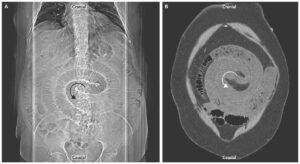This article is an answer to the Case – Violaceous Plaque Consisting of Four Concentric Rings on Leg
A 46-year-old woman with a history of infection with the human immunodeficiency virus (HIV) presented to the emergency department for evaluation of a painful rash. The CD4 cell count was 365 per cubic millimeter, the HIV load was undetectable, and the patient had not received antiretroviral therapy.
A violaceous plaque that measured 9 cm by 9 cm and consisted of four concentric rings with intervening areas of normal skin and numerous yellow-white pustules was found on the pretibial surface of the patient’s right leg. At the periphery of the rings, there was fine scaling of the skin.
The patient reported having been scratched by a cat in the same area three weeks earlier and had been treated with oral amoxicillin–clavulanate at a dose of 500 mg twice daily for 14 days with no noticeable improvement.
A skin-scraping specimen prepared with potassium hydroxide was evaluated microscopically and found to contain multiple hyphae. A diagnosis of tinea circinata was made.
Tinea circinata, an uncommon morphologic variant of tinea corporis, is caused by the dermatophyte Trichophyton tonsurans.

